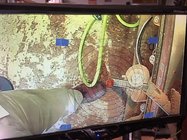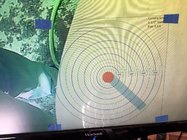I'm always interested in learning new things, try new tools. Founding the AAW chapter club here on the Island was mostly for selfish reasons. I wanted to know more. A club member came to show me the complete Trent Bosch hollowing system. I put a rough turned urn on my Stubby 1000, and we had some fun. I was sold within 10 seconds on the visualizer system!! I almost ordered it right then and there. But I remembered Alan Z talking about using Vmix for hollowing. So, I put my credit card back in my wallet and called my friend and mentor, Alan. I'm happy I did!! I had already installed one of my spare Logitech C920 cameras with a 1/4 screw where the laser goes on my Lyle Jamieson system. I had Vmix running and my extended monitor sitting on top of the headstock of the Stubby. I had not the perfect green screen, but a piece good enough. I tried to follow the instructions given by Alan during a webinar. But I could not do it all. We did a Zoom call, and within 15 minutes, Alan had the F1 key configured to do magic. You put the green screen below the cutter, press the F1 key and that sets a motion of 4 actions. The first one is a picture taken of the cutter. Then the picture is put into an overlay. So, let's say you are hollowing and need to move the cutter. You move it, put the green screen, press the F1 key, and you are ready to go. All in under 30 seconds. Simply amazing. I already had everything that I needed, the camera, monitor and computer. I do not have to draw on the screen. I have a picture of the cutter with different thicknesses for different projects. To know more about it, you can watch Alan's webinar:
View: https://youtu.be/uWhOBNFKmGY
The Vmix hollowing system talk starts at about 50 minutes. You can also contact Alan if you have any questions and or if you need help.
The Vmix hollowing system talk starts at about 50 minutes. You can also contact Alan if you have any questions and or if you need help.


